| Liverpool Commercial Quarter |
|
|||||||
| Liverpool Commercial Quarter |
|
|||||||
| allertonOak - home page | |
| merseyWalks - home page | |
Liverpool's Commercial Quarter began to emerge as the banking and insurance hub of the town during the 18th century. It also sits on the site of the mediaeval town, and the street patterns already established by the 14th century still survive. Nowadays the area is characterised by the monumental architecture of financial institutions dating from the latter half of the 19th century and the early 20th century. It also contains the magnificent Town Hall and several excellent and historic pubs. This walk around the Commercial Quarter is only about 2 miles (3 km) long, but a break for lunch or a pub visit would make a bit more of it. Like the Georgian Quarter, the area has a uniformity and a uniqueness of character within the city that create a special atmosphere, though the architecture would probably be the main attraction. The relevant Ordnance Survey 1:25000 Explorer map is No. 275. |
|
| Detailed maps and satellite imagery | |
| Mobile and printer friendly page | |
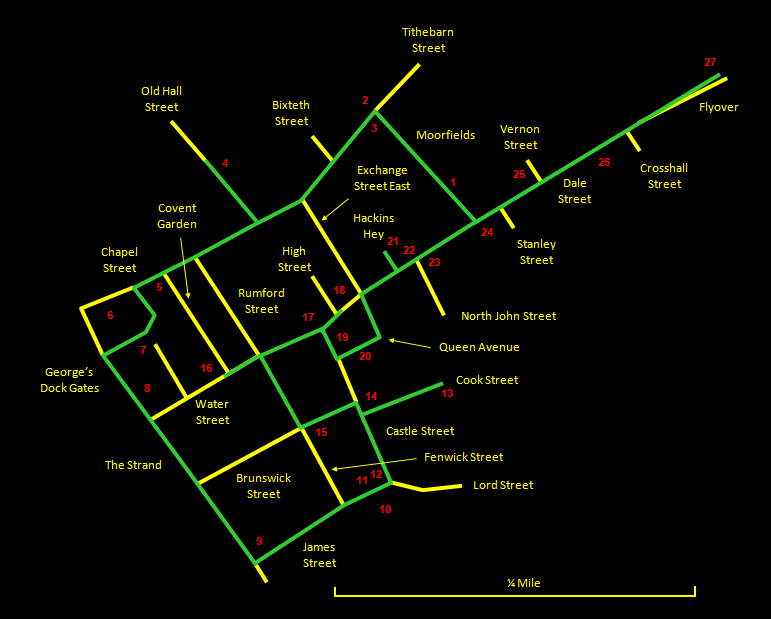 |
 |
You could, of course, start anywhere, but Moorfields Station (Moorfields exit) [1] would be the best place for those coming into the city by train. Turn right out of the station along Moorfields. At the top of the road on Tithebarn Street is the impressive Exchange Station Building (1888) [2], originally the terminus of the Lancashire and Yorkshire Railway. On the corner is a lovely Victorian pub, the Lion [3], which has one of the finest pub interiors in Liverpool. It may be too soon for a drink, but perhaps pay a visit at the end of the walk? Turn left along Tithebarn Street (one of the mediaeval streets along with its continuation into Chapel Street) and take a short detour to the right along Old Hall Street, another mediaeval street, to have a look at the attractive red brick, sandstone and polished granite Albany Building (1858) [4]. |  |
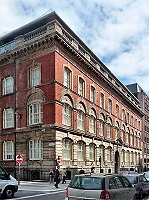 |
||
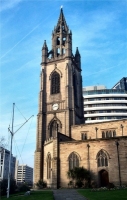 |
Return to Tithebarn Street and head down past Hargreaves Buildings (1859) [5] on the corner of Covent Garden to St. Nicholas's Church [6], now Liverpool Parish Church, at the end of Chapel Street. There has been a church on this site for perhaps 1000 years, originally the chapel of St. Mary del Quay. Until the construction of the docks and the Pier Head area on reclaimed land, this was the waterfront. The first church of St. Nicholas dated from 1361. There has been much rebuilding over the centuries; the present tower dates from 1815 and the body of the church, following wartime bombing, from 1952. Turn left off Chapel Street into the churchyard, a pleasant place to relax. On the edge of the churchyard is Ma Boyle's Oyster Bar [6], a curious little pub on several levels. Turn right out of the churchyard onto George's Dock Gates. On the right are the Pier Head Buildings and on the left the impressive white stone Tower Buildings (1910) [8], named after the Tower of Liverpool, a fortified town house (1406-1819) that stood on the site. The present building has three towers and vague suggestions of turrets. | 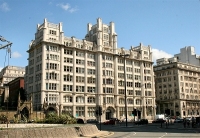 |
||
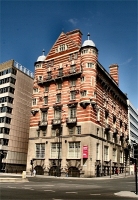 |
Carry on along the Strand to James Street, on the corner of which is the White Star Line Building (1898) [9]. The bands of red brick and Portland stone have earned it the nickname the Streaky Bacon Building. Turn left up James Street to Derby Square, the site of Liverpool Castle (c.1230-1726) and now of the Queen Victoria Monument (1906) [10]. The bronze sculpture of the Queen is accompanied by various allegorical figures: on the dome is Fame, above the supporting pillars are Justice, Wisdom, Charity and Peace, and surrounding the raised podium are Agriculture, Industry, Education and Commerce. On the north side of the square, the vaguely temple-like Castle Moat House (1840) [11], built for the North and South Wales Bank, has part of the old castle moat incorporated into a deep basement. Next door on the corner of Castle Street is the Alliance Bank (1868) [12], now Trials Hotel. |  |
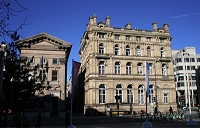 |
||
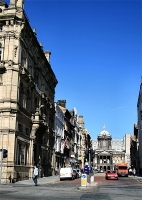 |
Turn into Castle Street, in mediaeval times the street connecting the town square called High Cross (on the site of the Town Hall) to the castle. From the 1840s, Castle Street was the city's principal financial street, as is still evident from the remaining buildings, many of which are now used for other purposes. It is one of Liverpool's grandest streets. Turn right off Castle Street for a short detour along Cook Street to view the remarkable No.16 (1866) [13]. The general shape of the building recalls old warehouse designs, with the central arch as the loading bay, but in other ways it looks forward to moderninsm, especially in its extensive use of plate glass. Have a quick peek inside, where there is decorative ironwork, including a spiral staircase. Return to Castle Street, where on the corner is the Grade I listed Bank of England Building (1848) [14], a masterpiece of Victorian architecture with Greek, Roman and Renaissance elements. | 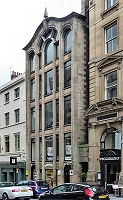 |
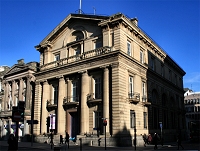 |
||
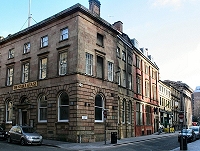 |
Turn left off Castle Street into Brunswick Street. The upper end of Brunswick Street has many fine buildings. On the corner of Fenwick Street, Heywood's Bank Building (1800) [15] is one of Liverpool's oldest commercial buildings and perhaps the first purpose-built bank in the city by quite a margin. Living accomodation was appended on the Fenwick Street side. Turn right along Fenwick Street to reach Water Street (another of the mediaeval streets along with its continuation into Dale Street). Take a short detour to the left, where, on the opposite side, is the Grade I listed Oriel Chambers (1864) [16] by the same archtect as No.16 Cook Street and another remarkably forward-looking building, with a cast iron frame and an unusually large amount of glass. | 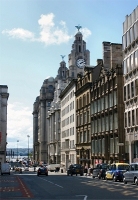 |
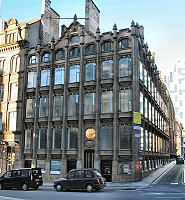 |
||
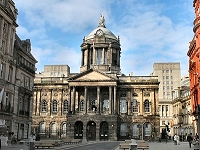 |
Return along Water Street to the the neoclassical Grade I listed Town Hall [17], imposingly situated at the junction of Water Street, Dale Street and Castle Street. It is effectively Liverpool's fourth town hall and is a magnificent building, no less so inside, around which pre-booked guided tours are available. It has its origins in 1754, but that building was gutted in a catastrophic fire of 1795. Elements of the shell, particularly on the Castle Street side, were retained and the first stage of the rebuilding, with a new dome on a raised drum, was completed in 1802. The portico was added facing Castle Street in 1811 but the reconstruction and decoration of the interior were not completed until 1820. A little further along on the corner of High Street at No.1 Dale Street is the grandiose Liverpool and London Insurance Company Building (1858) [18]. | 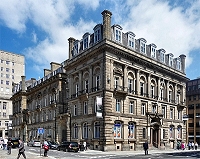 |
||
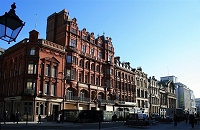 |
Return to the top of Castle Street. There are fine buildings on both sides here. On the left are the former art dealer's Agnew's (1877), the British and Foreign Marine Insurance Building (1890), the Queen Insurance Building (1888), the Scottish Equitable Chambers (1878), the Scottish Provident Building (1874), the offices of lawyer and developer Ambrose Lace (1846) and the Bank of England Building. On the right are the former jewellers shop of Robert Jones and Son, the Edinburgh Life Assurance Building (1897) and Parr's Bank Building (1901). Go down Castle Street to the British and Foreign Marine Insurance Building (1890) [19]. The striking colour of this building is down to the use of red brick, sandstone and terracotta. Above the first floor is a mosaic frieze of shipping scenes. The next building is the ornate Queen Insurance Building. Pass through an archway in the middle of the building to arrive in one of Liverpool's forgotten corners. Queen Avenue [20] exudes a bygone atmosphere with its peace and quiet, elegant buildings and antique street lamps. | 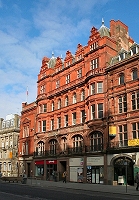 |
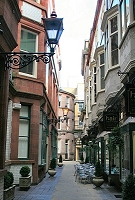 |
||
 |
|||||
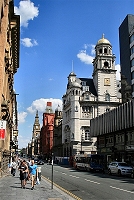 |
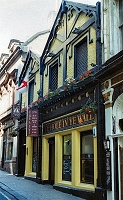 |
Queen Avenue emerges on Dale Street, in my opinion Liverpool's grandest street, especially the south side. The monumental line of architecture from the Royal Insurance Building via the Prudential Assurance Building to the Municipal Buildings was always intended to impress. On the corner of narrow Hackins Hey is an extraordinary concentration of pubs. Dale Street was the main coaching route out of Liverpool and always boasted a host of pubs, most of which have disappeared. Except for one. In Hackins Hey itself is the Hole in the Wall [21], which lays claim to being Liverpool's oldest surviving pub, dating from 1706 as a Quaker meeting house and 1726 as a pub. The interior retains the period character in abundance with tiny rooms, wood panelling and stained glass. An impressive polished brass fireplace proclaims the pub's antiquity. Just round the corner on Dale Street is Rigby's (c.1850) [22], another characterful old pub. The interior, though now opened up into three large rooms, oozes old-world charm. Along the eastern side of Rigby's is Leather Lane, a rare location where the more distant past can still be sensed. | 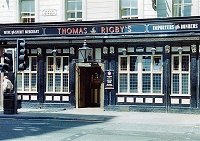 |
||
 |
|||||
 |
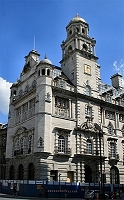 |
Opposite Rigby's, on the corner of Dale Street and North John Street, is the dominating presence of the grandiose Baroque-style Royal Insurance Building (1903) [23] with its golden dome 110 ft (34 m) above the street. Further along Dale street is the Prudential Assurance Building [24] in arresting red brick. The original building is dated 1886; the extension on the left with the tower was an addition in 1904-6. At the corner with Vernon Street is the Vernon [25], a nice, no-nonsense, traditional pub. Further along again comes the Municipal Buildings (1868) [26], designed in a suitably grandiose style, with suggestions of Classical, Gothic and French, for the Liverpool Corporation offices. Now, if you have any interest at all in beer, keep going to the end of Dale Street to the Ship and Mitre, an austere block of a building that holds within a veritable Aladdin's Cave of beer - a vast range of draft and bottled beers (and ciders). Suitably refreshed, head back to finish at Moorfields (or the Lion?) - cheers! | 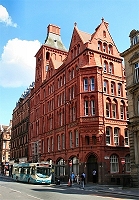 |
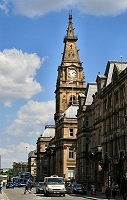 |
||
|